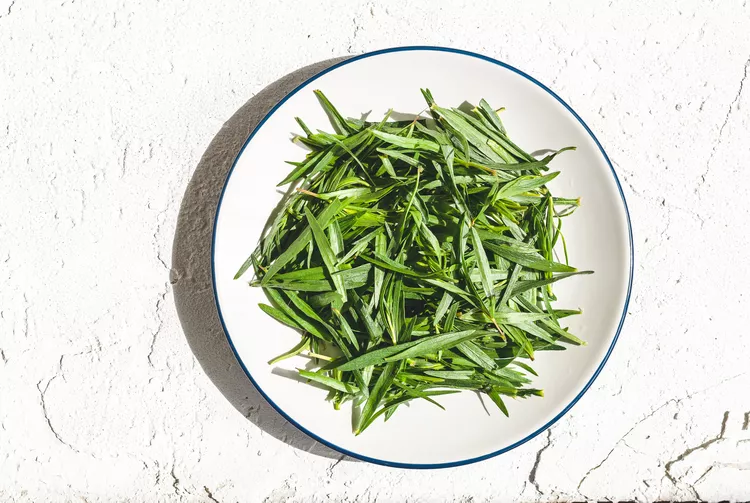What Is Tarragon? Discover How to Use This Versatile Herb

What is tarragon, exactly? If you ask the French, it’s “The King of Herbs.” If you ask us, it’s one of the most versatile soft herbs available, with a lightly sweet and anise-like flavor that works well in both sweet and savory creations.
There are three types of tarragon: French, Russian, and Mexican (aka Spanish). You’re most likely to find French tarragon (Artemisia dracunculus) at the supermarket or farmers market, and this variety has long, slender leaves that are somewhat reminiscent of wider, softer rosemary leaves. Fresh tarragon is one of the early-season produce items that’s a harbinger of spring, and it thrives all the way to early fall (around September in most parts of the U.S.). Tarragon is available on its own—in dried and fresh herb form—and is also sold in a blend called “fines herbes,” which is a mixture of chervil, chives, parsley, and tarragon.
Ahead, we’re digging into what tarragon tastes like, how to show it some TLC during storage so it stays fresh for as long as possible, as well as how the dried herbs stack up to fresh. Plus, we’re sharing the best tarragon recipe ideas, whether you’re in the mood for sweet or savory.
What Does Tarragon Taste Like?
All types of fresh tarragon have a hint of licorice flavor. Don’t worry: That feature is so subtle, even the anise-averse don’t usually mind it—and many find it extremely pleasant and enjoyable. While that aspect is quiet, tarragon as a whole packs a flavor punch that can totally transform a dish. French tarragon is also sweet, peppery, and grassy, with some mint, citrus, and vanilla notes, so it adds beautiful complexity to recipes.
The Mexican or Spanish variety tastes similar but slightly more robust, and Russian tarragon offers more bitterness.
How to Choose Tarragon
Look for fresh tarragon that has:
- Vibrant, sturdy, shiny, and bright green leaves
- Leaves that don’t look wilted, black, or yellow
- Strong, bright green stems
How to Store Fresh Tarragon
Once you have purchased or harvested your fresh tarragon, store it like fresh flowers: in a small cup, mason jar, or vase of water. Add a loose plastic bag on top to help maintain a humid environment, then place the tarragon on a shelf in the refrigerator.
Or wrap fresh tarragon in a damp paper towel, pop that into a zip-top bag, and store in the crisper drawer of your refrigerator. Stored under these conditions, it should last about 2 weeks.
Fresh vs. Dried Tarragon
All of those selection and storage tips relate to fresh tarragon, however dried tarragon is also available. Dried tarragon lasts longer, about 1 year when stored in an airtight container in a cool, dark place, and works well in certain instances (like casseroles, marinades, soups, or stews).
Since fresh herbs are mostly water, their flavor is less concentrated. If desired, use 1 teaspoon of dried tarragon for every 1 tablespoon of fresh tarragon called for in your recipe.
How to Use Tarragon
While it’s safe to eat both the leaves and the stems of fresh tarragon, the stems can err on the woody and thick side, so we recommend stripping the leaves off of the stems before adding fresh tarragon to any recipe. Discard or compost the stems, then use the leaves in your favorite recipes, either chopped or whole depending on the effect you’re going for.
Fresh tarragon is iconic in French Béarnaise sauce, a rich butter that’s similar to hollandaise. (Both start with clarified butter, egg yolk, and vinegar. Béarnaise features tarragon, shallot and black pepper, while hollandaise is seasoned with cayenne or white pepper.) It’s also stellar as a garnish. We particularly enjoy chopped fresh tarragon over anything that centers around stone fruit, lemons, or eggs, all of which play nicely with the flavor.
Beyond that, we also recommend that you try tarragon…
- As a true star of Tarragon Chicken Salad—the recipe calls for ½ cup!
- In and on top of Holiday Scalloped Potatoes
- As part of the marinade for this five-star Tarragon Shrimp with Easiest-Ever Risotto
- Infused into Tarragon Butter that’s an incredible dip for bread or lobster
- As the star of the dreamy dip in this Fried Sugar Snap Peas with Tarragon Aioli appetizer
- Tossed into the zoodles and the berry topping for Grilled Chicken with Blueberry-Tarragon Sauce
- Folded into Garden Mayonnaise that’s incredible over salmon, spread on sandwiches, or used as part of the dressing for potato salad (instead of regular mayo)
- In the cream sauce for Potato-Ham Bake, which is a brilliant way to “recycle” holiday dinner leftovers
- Infused into vodka for 4 days, then strain the leaves to add a light herbaceous boost to cocktails
- Steeped into the custard for vanilla or peach ice cream, crème brûlée, pudding, or panna cotta
- Folded into the dough for shortbread or sugar cookies
- Showered into a fruit salad
The Best Tarragon Substitutes
If you can’t find or don’t prefer the flavor of tarragon, herb substitute options abound. Feel free to tag in:
- Basil
- Fennel fronds or seeds
- Thyme
- Rosemary